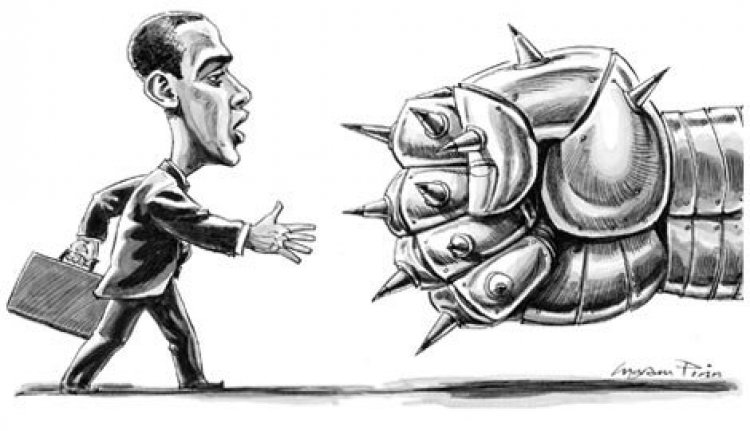India’s ‘Soft Power’ vs ‘Hard Power’
Asia News Agency

India’s ‘soft power’ historically has had more influence than its ‘hard power’. What is, however, not adequately recognised, writes Sanjaya Baru (political commentator and policy analyst) “is that sometimes ‘soft power’ can even do the job of ‘hard power’.
Examples of ‘soft power’
For example, “Mahatma Gandhi’s non-cooperation movement was an example of how soft power was used to confront the hard power of an imperial regime, resulting in the eventual non-violent overthrow of two hundred years of colonial rule.”
In another example, “India became the ‘Voice of the Global South’ way back in the 1950s as a consequence of the soft power appeal of Mahatma Gandhi and Jawaharlal Nehru across the post-colonial world…”
Dealings with China: In dealing with China too, “India has had more success in the past deploying the soft power of its liberal, pluralist democracy rather than the insufficient hard power that it possesses…..Even the success of the G-20 summit in New Delhi can be attributed to Indian soft power…”
While China still scores in Africa using hard power, Baru writes “India carries weight across the continent due to its soft power. India’s membership of G-20 was in part due to its soft power, given that it has the lowest per capita income among the G-20 countries…..India’s democratic credentials rather than hard economic power helped it sit at the global high table.”
India’s case for membership of the United Nations Security Council “has been made more effectively by drawing global attention to the soft power of Indian democracy and her civilisational attributes than any muscle flexing and display of hard power. A civilisational nation, home to four of the world’s seven great religions, a nation of well over a billion people, home of some of the world’s oldest languages, and so on and so forth. How can any global organisation of nations not give India a pride of place along with the countries of Europe and Asia?”
BJP’s muscular approach
Prime Minister Narendra Modi has however, practised ‘hard power’ at the same time. An example is the Balakote air strike deep within Pakistan. The recent controversy around the killing of a person of Indian origin in Canada - Hardeep Singh Nijjar - may have dented India’s reputation, “even though the government has denied any involvement and rejected all insinuations. Given that the present government in New Delhi has often claimed credit for its deployment of hard power, its denial of any involvement in the killing in Canada is being taken with a pinch of salt. When a political leadership takes pride in its ‘muscular’ approach to national security, such denials of such actions are naturally viewed with some doubt.”
Using ‘hard power’: costs to be borne
In the context of the killing of Hardeep Singh Nijjar in Canada, Parveen Swami (National Security Editor, ThePrint) mentions “there’s mounting evidence……that India’s external intelligence service, the Research and Analysis Wing, is seeking to expand its ability to target the country’s enemies on a global scale. The campaign is winning the government applause–but its costs must also be dispassionately considered.”
This has been done even by governments before the present BJP’s.
"Through the 1980s, when the ISI staged attacks against civilians in Punjab, India had hit back with its own savage bombing. ‘The role of our covert action capability in putting an end to the ISI’s interference in Punjab by making such interference prohibitively costly is little known,’ former RAW officer B Raman wrote in 2002. In Bangladesh, India hollowed out Pakistan’s power by raising a covert army; it exercised political influence in Nepal and Sri Lanka through its covert services.”
Doctrine of ‘offensive defence
Presently, National Security Advisor Ajit Doval, a highly-regarded Intelligence Bureau veteran, is credited for what he called a doctrine of ‘offensive defence’.
The record, writes Swami “shows the results of the new strategy have been, at best, ambiguous. Following the terrorist attack at Uri in 2016, India struck across the Line of Control. The ISI responded with a series of effective fidayeen suicide-squad strikes against Indian military installations. The Balakot crisis raised the stakes, and led to a sharp reduction in terrorist violence. That hasn’t stopped the ISI, though, from regularly targeting Indian troops.”
True, concedes Swami “India’s covert campaign appears to have secured some notable successes—among them, the killing of ageing Khalistan patriarch Paramjit Singh Panjwar, long sheltered in Pakistan, and transborder weapons trafficker Muhammad Riyaz. R&AW is also alleged to have killed former al-Badr commander Syed Khalid Raza, and Hizb-ul-Mujahideen operative Bashir Pir. Killings like these, though, do not transform the security landscape in any meaningful sense: dozens of more important jihadists, after all, are killed in combat in Kashmir each year.”
In some cases, emphasise Swami “the covert campaign comes with significant diplomatic costs.” Thus “for covert influence to be exercised effectively….India will need more than one tool—and be thoughtful if when and how it exercises them. The use of the knife might provide a kind of primal emotional satisfaction, but that isn’t the same thing as national power.















